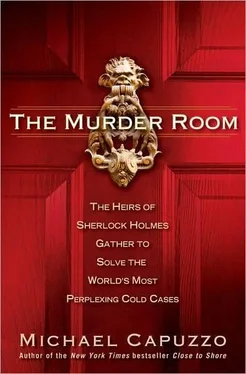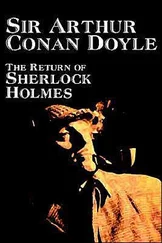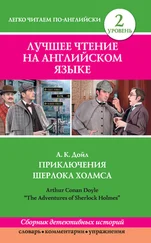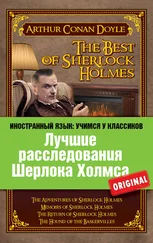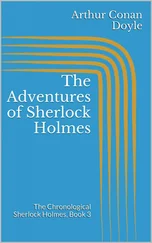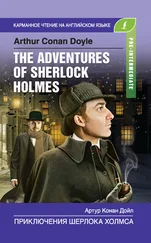But on June 5, as delegates poured into town for the GOP convention set to start in three days, a head detached from the body of a tattooed man was discovered by the train tracks in Kingsbury Run. In a brazen affront to Ness, the killer hid the body in bushes in full sight of a police station. On the Sunday afternoon in September when star Cleveland Indians pitcher Bob Feller struck out seventeen Philadelphia A’s, more than five thousand people gathered around a sewage pit to watch a diver retrieve the arms and legs of the Butcher’s eighth victim.
The mayor ordered Ness to act. The Cleveland Press demanded: “Unusual means must be taken to bring the detection of one of the most horrible killers in criminal history.”
Ness responded by putting twenty detectives on the case, including undercover hoboes. He sought advice from the experts at Scotland Yard. He expanded the investigation to the largest in city history. Police brought in ten thousand possible suspects for interviews, focusing on physically strong men who were surgeons, medical personnel, male nurses, and animal butchers. Detective Pete Merylo paraded through shantytowns in his long johns under the moonlight to “bait” a killer he was convinced was homosexual. Nothing worked. By 1938, the Butcher of Cleveland had killed and dismembered twelve men and women.
Ness ’s dragnet finally turned up a prime suspect. Dr. Frank E. Sweeney was a surgeon from a prominent family, the first cousin of a local Democratic Party boss. On the surface an impressive, articulate man, Dr. Sweeney was known to be an alcoholic, mentally unstable, and abusive; his wife had left him. Furthermore, he was physically huge, quite capable of all the cutting and moving about of human remains. His frequent disappearances from the hospital where he worked, timed to some of the killings, had aroused suspicion, and Ness himself had been frightened by the big man’s anger when alone with him.
Ness’s instincts were confirmed when another crime-fighting legend, Leonarde Keeler, inventor of the polygraph machine, came in from Chicago and administered several lie detection tests to Sweeney, who failed them all. The surgeon, the polygrapher told Ness, was “a classic psychopath.” Sweeney was following in the footsteps of his father, an alcoholic, violent schizophrenic who was committed to mental hospitals at the end of his life. Keeler said, “You’ve got your man.”
But Ness faced a quandary. He was reportedly convinced that Sweeney was the Butcher of Cleveland. Yet he didn’t believe he’d ever win a conviction of the politically connected Sweeney. Two days later, in what some suspected was a deal Ness cut with the prominent family, Dr. Sweeney voluntarily committed himself, and never saw the outside of a mental hospital or hospital for the rest of his life. The Cleveland killings stopped, but the murderer moved on to other parts of Ohio and Pennsylvania. Meanwhile, it was too late for Ness. His reputation had already been damaged by allegations of heavy drinking and skirt-chasing that facilitated the breakup of his marriage. His long failure to stop the serial killer’s reign of terror left him especially vulnerable to political enemies and the press. It was the makings of an American tragedy.
On an icy winter night in 1942, after he fled the scene of a car accident at 4:30 in the morning following a night of drinking and clubbing, Ness was forced to resign his post. His second wife, a young model and art student, left him soon after. The former crime-fighting wunderkind descended through a series of career and business failures in New York and Washington, D.C., to the remote mountain town of Coudersport, Pennsylvania, where he drank heavily with his third wife and continued to tell wild stories in the bars about Al Capone that few believed. An old friend, sportswriter Oscar Fraley, embellished those stories in his highly fictionalized account of Ness’s life, The Untouchables, which made Ness an American legend. But Ness didn’t live to see the book. In May 1957, he walked back to his small-town apartment from the liquor store with another whiskey bottle and died of a heart attack at the kitchen sink, at the age of fifty-four. It was said the Butcher had taken yet another victim.
The subject seemed “graphic” to the Times reporter. Philadelphia boasted “enough bizarre killings… to keep a full house at the morgue and make homicide detectives and medical examiners wish they could get away from it all,” he said, marveling that “when some of them do take a break, they like to sit back and listen to the one about the Cleveland torso murders.”
Adding to the sense of drama in the room, the case would be presented by two renowned investigators from sharply different traditions that were increasingly in conflict. Philadelphia homicide captain Frank Friel was an old-school, shoe-leather detective, rooted in the solid nineteenth-century procedure of building a case from fact-gathering at the crime scene. He would be followed by forensic psychologist Richard Walter, one of a small group of pioneers who read bloodstains and patterns at murder scenes like Rorschach tests. At their best, they seemed to be wizards capable of reading a killer’s thoughts. It was a face-off between natural opponents-two proud, strong-willed figures who were oddly well matched, both tall, lean, and charismatic men who used wit to mask a fierce demeanor.
As lunch dishes were cleared, Friel opened the floor to questions. He challenged the Vidocqeans: Who was the Butcher of Cleveland? Fleisher was delighted. It was just the kind of forensic puzzle he had imagined. Could a college of top investigators surpass Eliot Ness? Could they solve the mystery of “The American Jack the Ripper”?
The question-and-answer period was brisk. Friel and others maintained that Ness correctly focused the investigation on cutting trades such as surgeons and butchers. “The principal characteristic of the assailant was that he decapitated the victims while they were still alive,” Friel said.
Customs agent Frank Dufner saw it as the work of an angry medical student. “Did anyone flunk out of medical school?” he asked.
The fact that the bodies were drained, did anyone consider an undertaker? a police officer asked.
Yes, Friel said, medical students and undertakers had been questioned.
“Seven out of twelve of the heads were not found,” Dufner continued. “Were they kept as trophies?” Friel couldn’t say.
Fleisher had scribbled in a notebook: undertaker, butcher, abattoir. But by the end of the presentation, he was convinced the surgeon, Dr. Sweeney, was the killer. “If Leonarde Keeler says he was the guy, he was the guy. Keeler was one of the inventors of the polygraph, and a master at it.”
While busboys removed the lunch plates, “the fact of the matter is, Eliot Ness did some good things, was a hero to an extent,” Walter said, “but was out of his depth in this case because of his limited knowledge in the 1930s of serial killers.”
Walter leaned in and said, sotto voce, “Of course, the FBI still doesn’t understand much of this, so we shouldn’t be so hard on Ness.” Several VSMs chuckled along with him.
To start, Walter said, Ness was mistaken to narrow the investigation to large, strong men and professionals or tradesmen expert with a knife. “You don’t have to be a butcher to carve someone into little pieces or an undertaker to drain them of blood. The fact of the matter is anyone can do it, and do it competently. You just have to want to.” He smiled coldly, and went on. “In addition the killer doesn’t have to be big or powerful. He can be a small man. All he has to be is clever. He gets them drunk, then he can do anything to them.”
Second, Walter said, Dr. Sweeney, Ness ’s main suspect, “was a lousy choice to be the Butcher, for all the reasons that supposedly implicate him. He’s violent, alcoholic, schizophrenic. That makes him an asshole, but it doesn’t make him a sadist.” It was clear from the corpses that the Butcher of Cleveland was a sadistic serial killer, and Sweeney didn’t fit that profile.
Читать дальше
